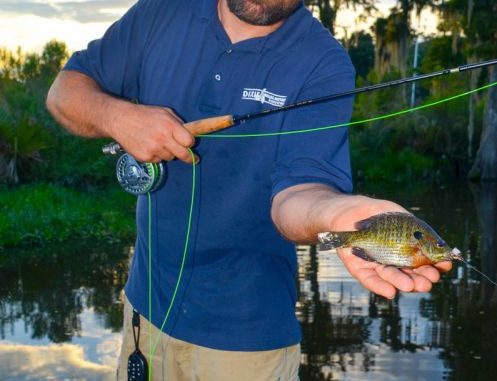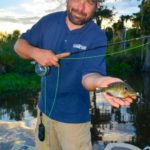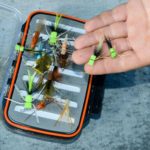
Don’t neglect the long rod for bream
Todd Schultz throws bugs at fish.
Not real ones; fake ones — foam spiders. But the fish are real.
Fly rod in hand, Schultz stepped from his dock into the stern of his well-worn 14-foot aluminum flatboat. The boat doesn’t have a noisy gas-burner hung on the transom. Instead, Schultz relies on an 80-pound thrust, 24 volt Minn-Kota I-Pilot trolling motor.
“It’s a little overkill,” he admitted with a grin, “but I like it.
“I don’t like hand control motors because you are married to the bow. When you are fly fishing you have line all over the deck and fly lines tangle on everything. So you want to be away from the trolling motor.
“Line management is a big thing.”
His experience at fly fishing is obvious. He makes several false casts, feeding line out with each stroke of the rod until his gut tells him he has enough and then lays the bug on the water with a gentle kiss.
After delivery, he twitches the bug sporadically, slowly moving it away from the bank, ready to suck it up for the next cast. The anticipation of bluegill’s or stumpknocker’s lightning-like “splock” as it hits the bait was almost excruciating.
It was easy to understand why he calls his slipping away from work for this in the evening once or so a week “stress relief.”
As for the fishing part, Schultz, like many fly fishing aficionados, is willing, even eager to offer advice to those new to the sport, at least after offering an opening caution.
“Fly fishing is not for everybody. It takes a lot of effort and skill to do it.” If he was trying to discourage anyone, he wasn’t very convincing.
For bream, Schultz uses a 3 weight, 8 ½-foot Temple Fork Outfitters rod. He calls it a “working man’s rod,” at a cost of $300. “You can go to Orvis and spend $800.
“Or you can go to K-Mart and buy a rod for $30 or $40, but you can really tell the difference. A good rod just feels better.”
He uses a Wright & McGill single action reel that goes for about $100. “It’s good quality, but not top-of-the-line,” he said. “You don’t really need more, certainly not a reel like one used for redfish.
“I never fight these fish on the reel, like with redfish. I always hand-strip the line to fight these fish.”
Schultz uses floating fly line and recommends buying the very best. “They feel like silk when stripping them through your fingers. Cheap lines feel abrasive.”
He uses 10-pound test fluorocarbon leaders because of where he fishes, allowing him to yank the fly out of the bayou’s lush growth of trees and grass when it hangs he misses his target. Most people use 2- or 4-pound test lines for bream fishing, he noted.
His leader is attached to the fly line loop-to-loop, with the loops being constructed with surgeon’s knots.
He is non-specific about his choice of flies, or “bugs,” as he calls them. “I like anything that’s fairly small, looks like a spider or cricket and has elastic legs.”
In spite of his love of fly fishing, he isn’t a fly snob though, noting “You can come in here with crickets and a bobber and clean up on them.”
Flying on Castine
Access to Bayou Castine is easy, said Todd Schultz. A modern three-ramp backdown boat ramp has been constructed at the dredged mouth of Bayou Castine, where it empties into Lake Pontchartrain. The Mandeville Boat Launch is located at 100 Jackson Avenue in Mandeville.
Bayou Castine isn’t just for bream, Schultz emphasized. “In October, believe it or not, in pure freshwater, we catch lots of speckled trout as far up the bayou us as my dock.
“The bayou has lots of catfish too, big and little,” he stated. “My girlfriend Julie Deal caught a 30-pounder on 2-pound test line.
“Big gar are here too!”

